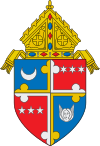
Oxon Hill is an unincorporated area and census-designated place (CDP) in southern Prince George's County, Maryland, United States. Oxon Hill is a suburb of Washington, located southeast of the downtown district and east of Alexandria, Virginia. It contains the new 300-acre (120 ha) National Harbor development on the shore of the Potomac River.

Maryland Route 414 is a state highway in the U.S. state of Maryland. The highway runs 5.64 miles (9.08 km) from the beginning of state maintenance in Forest Heights east to MD 5 in Silver Hill. MD 414 connects the inner suburbs of Oxon Hill, Marlow Heights, and Silver Hill and provides access to National Harbor. The highway was constructed through Oxon Hill and Marlow Heights in the early 1930s. MD 414 was extended through Silver Hill along the old alignment of MD 5 when that highway bypassed Silver Hill in the early 1950s. The highway was expanded to a divided highway between Marlow Heights and Silver Hill in the early 1970s, around its interchange with Interstate 95 (I-95) and I-495 in the early 1980s, and around MD 210 in Oxon Hill in the late 1980s. MD 414 was reconstructed around MD 210 again in the mid-2000s with the construction of National Harbor and the new Woodrow Wilson Bridge.
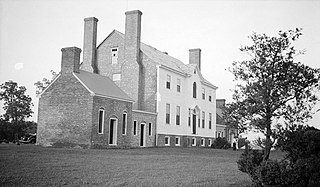
Rose Hill is a historic house built in the late 18th century near Port Tobacco in Charles County, Maryland, United States. It is a five-part, Georgian-style dwelling house. It has a two-story central block with gable ends. It was restored during the mid 20th century.
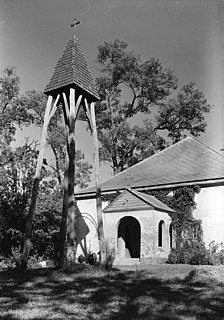
Broad Creek in Prince George's County was the first footprint of European settlement in the immediate counties around what would become the nation's capital, Washington, D.C. The area is part of greater Fort Washington.

Laurel is a historic passenger rail station on the MARC Camden Line in Laurel, Maryland, between the District of Columbia's Washington Union Station and Baltimore's Camden Station.

Oxon Cove Park and Oxon Cove Farm is a national historic district that includes a living farm museum operated by the National Park Service, and located at Oxon Hill, Prince George's County, Maryland. It is part of National Capital Parks-East. It was listed on the National Register of Historic Places in 2003.

His Lordship's Kindness, also known as Poplar Hill, is a historic plantation estate on Woodyard Road east of Clinton, Maryland. It was built in the 1780s for Prince George's County planter Robert Darnall. The five-part Georgian mansion retains a number of subsidiary buildings including a slave's hospital and a dovecote. The property is now operated as a museum by a local nonprofit preservation group. It was designated a National Historic Landmark in 1970.
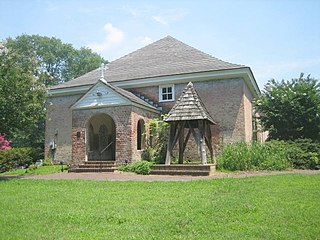
"St. John's Church", "St. John's Episcopal Church", or "St. John's Episcopal Church, Broad Creek", is a historic Episcopal church located at 9801 Livingston Road in Fort Washington, Prince George's County, Maryland. It is a rectangular Flemish bond brick structure with a bell hipped roof. The interior features a barrel vaulted ceiling with an intricate support system.

Oxon Hill Manor is a neo-Georgian house of 49 rooms, located at Forest Heights, Prince George's County, Maryland. It was designed in 1928 for Sumner Welles (1892-1961) by the Washington architect, Jules Henri de Sibour (1872-1938). It was built in 1929, and consists of a two-story main block of Flemish bond brick and a northern wing. Also on the property are two outbuildings contemporary with the house; a five-car garage and attached manager's quarters and greenhouse, and a stable. There are also formal gardens on the grounds.

St. Matthew's Church, also known as Addison Chapel, is a historic Episcopal church located at Seat Pleasant, Prince George's County, Maryland.
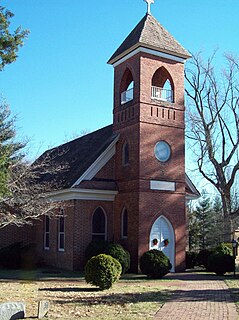
St. Thomas' Church is an Episcopal church in a rural setting, located at Croom, Prince George's County, Maryland. It is one of four congregations that have constituted the parish of St. Thomas in the Episcopal Diocese of Washington, the others including the Church of the Atonement in Cheltenham, the Chapel of the Incarnation in Brandywine, and St. Simon's Mission also in Croom.

Middleham Chapel is a historic Episcopal church located in Lusby, Calvert County, Maryland. It is a one-story, cruciform, Flemish bond brick structure with exposed fieldstone foundations. It was built in 1748, to replace an earlier frame or log structure believed to have been erected as early as 1684, as a Chapel of Ease of Christ Church Parish. The date of construction is worked into the brick on the front of the church.

St. Ignatius Roman Catholic Church is a historic Roman Catholic church located at St. Inigoes, St. Mary's County, Maryland. The church and its adjacent burial ground are situated on about two acres of land that are enclosed within a late 19th-century iron fence. The church was constructed between 1785 and 1787, with the sacristy added in 1817. The church walls are 21 inches thick, of brick laid in Flemish bond. Atop the roof is a small wooden belfry that in 1933 replaced a larger one in this same location.
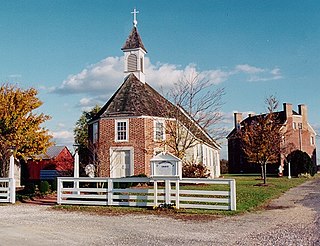
St. Francis Xavier Church and Newtown Manor House Historic District is the first county-designated historic district in Saint Mary's County, the "Mother County" of Maryland and is located in Compton, Maryland, near the county seat of Leonardtown. The district marks a location and site important in the 17th-century ecclesiastical history of Maryland, as an example of a self-contained Jesuit community made self-supporting by the surrounding 700-acre (2.8 km2) farm. The two principal historic structures were added to the National Register of Historic Places in 1972. Archaeological remains associated with the site date back to the early colonial period, mid-17th century.

St. Thomas Manor (1741) is a historic home and Catholic church complex located near Port Tobacco, Charles County, Maryland. Known as St. Ignatius Church and Cemetery, the manor house complex is the oldest continuously occupied Jesuit residence in the world. The mission settlement of Chapel Point was established in 1641 by Father Andrew White, S.J., an English Jesuit missionary. Father White administered to the Potapoco Native Americans, some of whom he converted to Catholicism. Established in 1662, this is the oldest continuously active Roman Catholic parish in the American Thirteen Colonies. With the consecration in 1794 of Bishop John Carroll, St. Thomas became the first Roman Catholic see in the United States.

St. Ignatius Church is a historic Roman Catholic Church located at Forest Hill, Harford County, Maryland. It is a rubble stone, one-story rectangular structure of five bays, with a tall tower at the west end and a rubble stone two-story rectangular addition. The original 35 feet by 50 feet church was built between 1786 and 1792.

St. Luke's Church is a historic Episcopal church located at Church Hill, Queen Anne's County, Maryland. It was built between 1729 and 1732 as the parish church for St. Luke's Parish, which had been established in 1728.

St. Alphonsus Church, Rectory, Convent and Halle, also known as St. John Neumann Shrine and "Baltimore's Powerhouse of Prayer," is a historic Roman Catholic church complex located within the Archdiocese of Baltimore in Baltimore, Maryland, United States. Since 1992, the parish has held regular Tridentine Masses. It is currently administered by the Priestly Fraternity of Saint Peter.

St. Thomas' Episcopal Parish Historic District is a national historic district located at Croom, Prince George's County, Maryland. The district encompasses four contributing buildings and three contributing sites associated with St. Thomas' Church. The other contributing buildings are the Gothic Revival style St. Thomas' Church Rectory (1852-1853), Tenant/Sexton's House, and tobacco barn. The contributing sites are the St. Thomas' Episcopal Church Cemetery, St. Simon's Mission Chapel Site, and St. Simon's Cemetery. The African-American communicants of St. Thomas' Church formed St. Simon's Mission Chapel in the late-19th century and it operated on the property associated with the Croome Industrial and Agricultural School, which operated from about 1902 to 1952.

Divine Worship: The Missal (DW:TM) is the liturgical book containing the instructions and texts for the celebration of Mass by the former Anglicans within the Catholic Church in the three personal ordinariates of Great Britain, United States and Canada, and Australia. The rite contained in this missal is the Anglican Use, a variant of the Roman Rite Mass with elements of Anglican worship. It was approved for use beginning on the first Sunday of Advent, November 29, 2015.

























